The Surface 3 Review
by Brett Howse on May 4, 2015 9:00 AM ESTGPU Performance
The Surface 3 with the Atom x7-Z8700 pairs the Intel Gen 8 Graphics from Broadwell with the Airmont CPU cores of Atom. Unlike the Broadwell cores though, the Surface 3 SoC only has 16 execution units (EUs) as compared to 24 in Core M. The maximum frequency is also reduced to 600 MHz for these cores, as compared to up to 900 MHz in Core M. This is all necessary to keep the x7-8700 in the 2 watt SDP.
So performance will be a step back compared to Core M, but really this should be no surprise. The interesting comparison will be how it compares to Surface Pro 3 with Haswell Gen 7.5 graphics and of course to Bay Trail equipped tablets.
We will start with some synthetic tests and then move on to DOTA 2 to see how it performs on a real world game.
3DMark Tablet
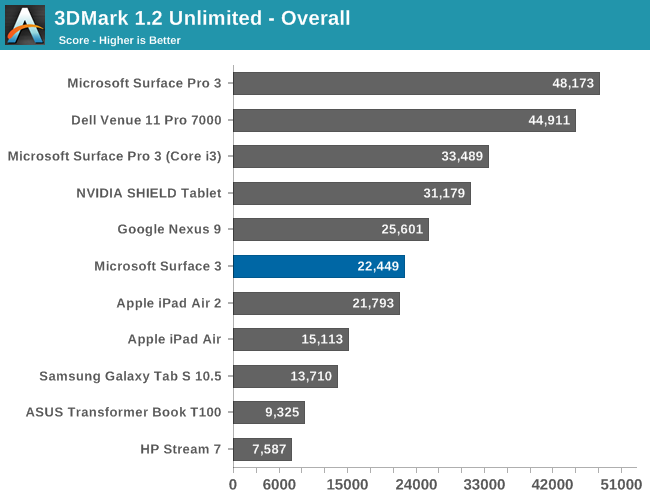


The GPU upgrade is a big improvement over the ASUS T100's Bay Trail graphics, but the Atom GPU still can not compete with the fastest tablet SoCs out there.
3DMark Notebook
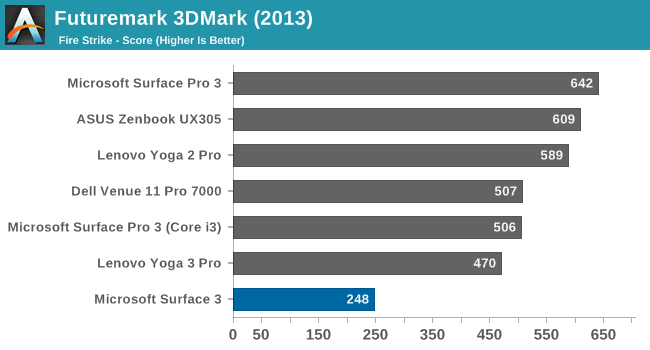
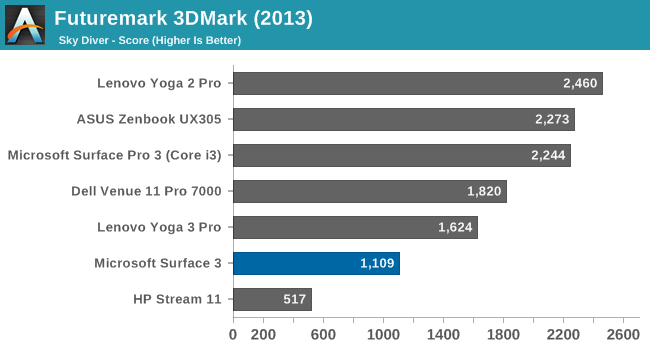
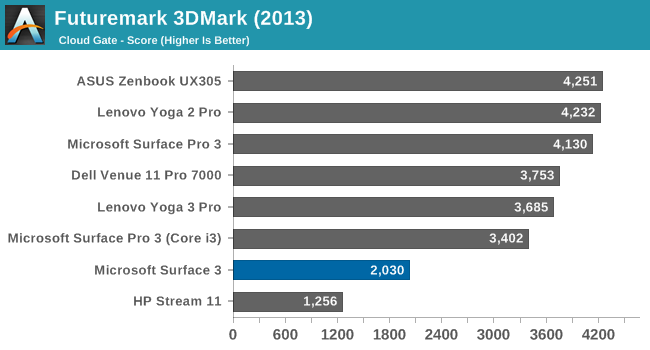

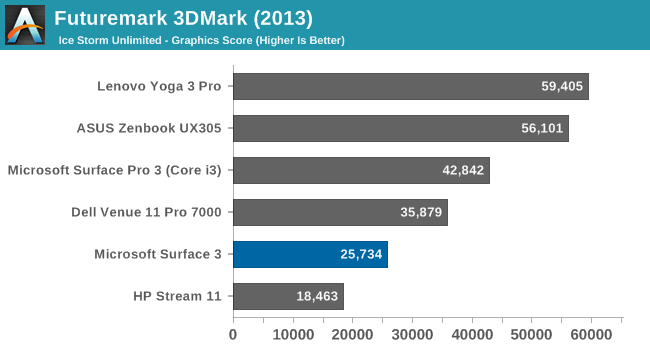
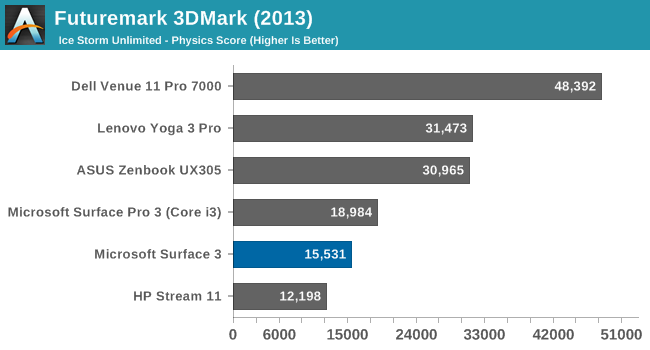
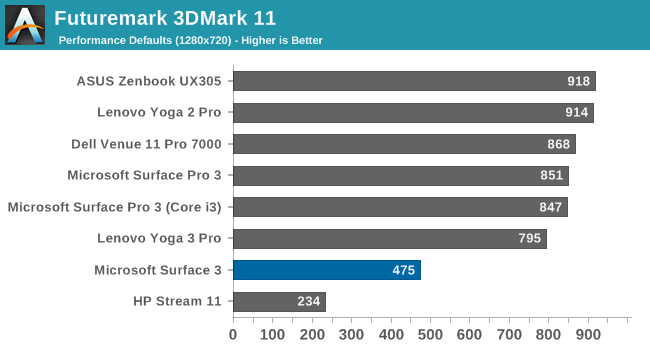
Comparing the Surface 3 to PC class hardware puts it in a pretty poor light when looking at GPU performance. Our 3DMark tests have the Surface Pro 3 with the Core i3 on average 40% faster than Surface 3. Comparing it to the Dell Venue 11 Pro with Core M, we find the Core M GPU is on average 47% faster, which is quite a gap. Let’s not forget though that the Surface 3 is a mere 2 watt SDP, whereas Core M is a 4.5 W TDP and the Haswell-Y in Surface Pro 3 is an 11.5 W TDP.
GFXBench Tablet (OpenGL)
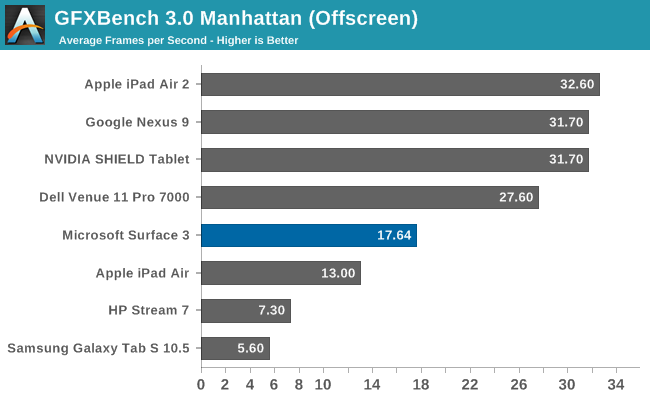
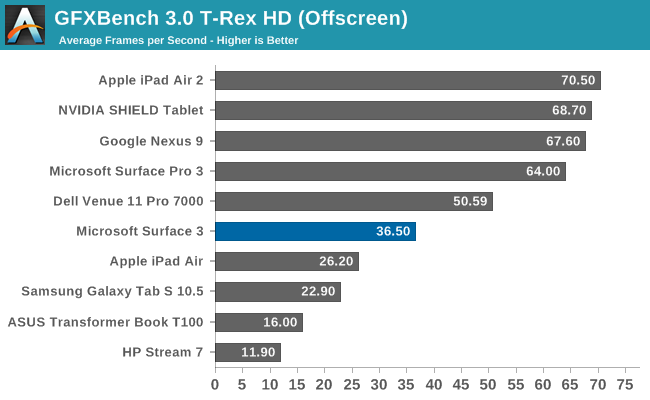
As with the 3DMark scores, the GPU upgrade is significant, but still a ways back of the best tablet GPUs out there. Intel still has some work to do on this front.
GFXBench Notebook (DirectX)
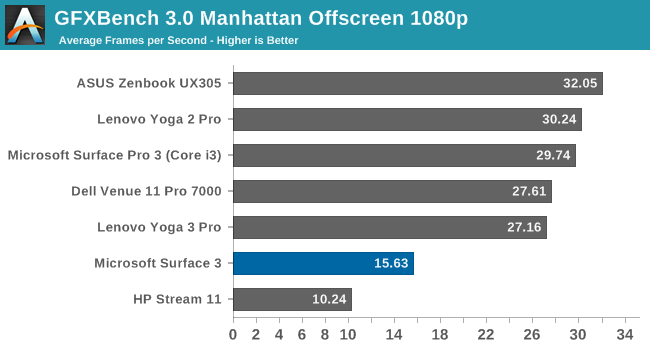
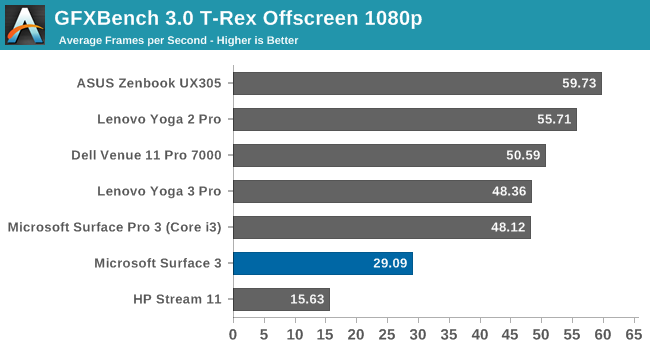
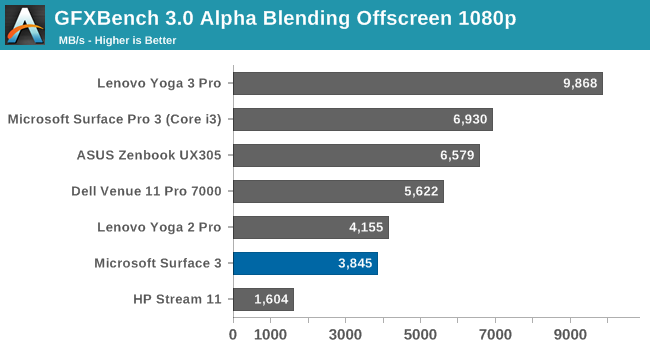

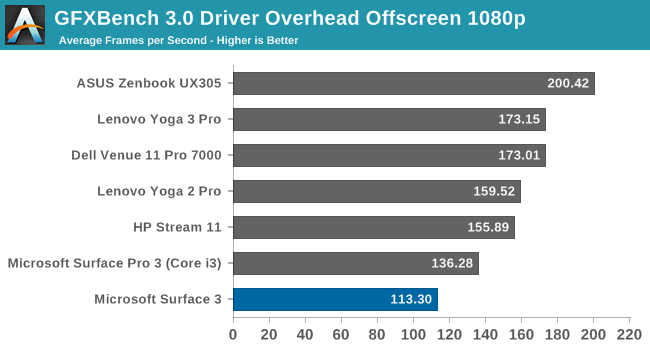
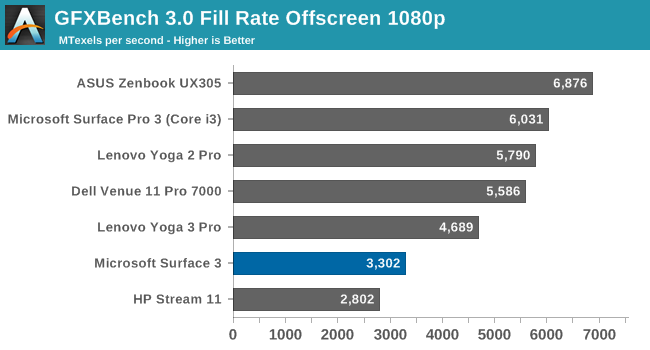

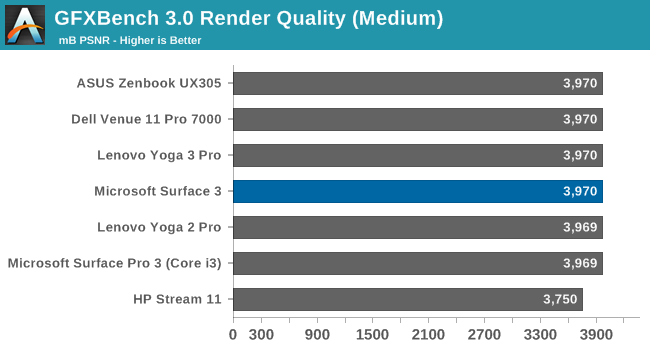
We see a similar story with GFXBench on the notebook side. The 16 EUs in our Atom SoC just cannot compete against the larger and faster GPUs in Core.
Moving on to a real-world game, we use a custom DOTA 2 benchmark for our lower powered devices. It is a very popular battle-arena game, and the GPU requirements are not too demanding.
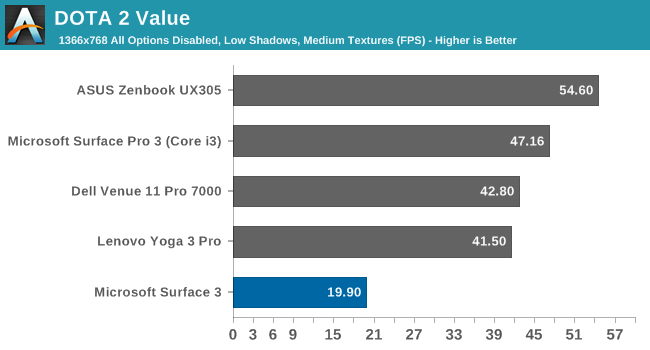
The GPU in the Surface 3 is really not enough to play most games, and even on our value settings, the Surface 3 is not a great experience for DOTA 2. The higher TDP of Core M lets it do ok in this test, but overall the Surface 3 is a long way back of even the Surface Pro 3 Core i3.
Storage Performance
Like most tablets, the Surface 3 utilizes eMMC storage rather than the SSD storage found on higher priced laptops and Core M tablets. It costs less, it is less complex, and it works. So expectations are that it will not be able to compete with the fastest solutions out there. But as a tablet, workloads should be less complex, at least in theory.
Unfortunately Microsoft shipped me the 64 GB version of the tablet, and due to PCMark 8 requiring a large amount of free space in order to perform its tests, it was unable to be run on this device. But we have run into this issue in the past, and we can turn to a couple of other tools to get a feel for how the storage performance is. Even though eMMC is slower than a good SSD, there is still different levels of performance based on the NAND in use and the controller.
I ran CrystalDiskMark over a 4 GB span and the results are below.
Surface 3 eMMC Storage (left) vs Surface Pro 3 Core i3 SSD (right)
Compared to a true SSD, the eMMC performance leaves a lot to be desired. In fact, most of the time when I was using the tablet and I found it slow, such as installing software, or loading programs, it was mostly disk bound. There are faster eMMC options available, but I will refrain from comparing it to other tablets since we do not have the same benchmarking tools for both.


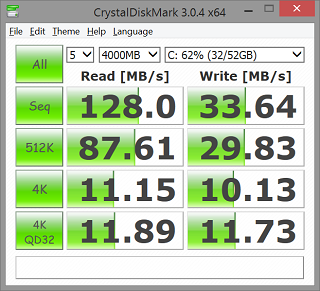
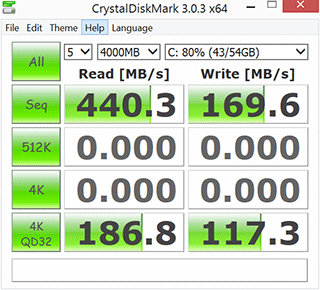








265 Comments
View All Comments
RafaelHerschel - Tuesday, May 5, 2015 - link
That is a weird statement. Whose fault is it then? You're right about one thing though, AMD is woefully behind Intel. I wish it wasn't so, but I don't see AMD making any real progress soon.At this point efficiency is king and Intel with their 'mobile first' philosophy is now becoming a viable alternative for the mobile market. Sadly I don't think that AMD has the budget to compete.
lilmoe - Thursday, May 7, 2015 - link
If we're talking efficiency, then ARM is king IMHO. The upcoming custom ARMv8 designs should give Intel a run for their money. AMD's Zen cores were developed with mobile first in mind with supposed great single threaded performance. It'll be interesting to see how things fold out. Too bad we'll have to wait a year at least for that.I should have been more specific though. I should have said that it wasn't "entirely" AMD's fault since process nodes of other fabs haven't been up to par. It'll be interesting to see AMD's Zen at 14nm vs Intel's Skylake at 14nm.
lilmoe - Thursday, May 7, 2015 - link
Oh, forgot to say that the initial point was about GPUs. Even with a process lead, Intel still can't come up with a decent GPU, even compared with ARM SoCs.LogOver - Monday, May 4, 2015 - link
Do Mali or PowerVR GPUs support DX at all? And if so, how good the support is? Last time I checked there were big issues with PowerVR Windows drivers. I'm not sure if these GPUs has any good support for something other than OpenGL ES. I guess the missing features are the reason that these GPUs are so "efficient".dusk007 - Monday, May 4, 2015 - link
According to the specs http://www.arm.com/products/multimedia/mali-perfor...Mali T760 supports OpenGL 3.1 and DirectX 11. Since Dx12 does not need different hardware that should be in the cards too. They all run the Windows mobile version so drivers are available. And features are all there. Intel is just not doing a very good job.
Considering the money and resources Intel has they really should do better.
LogOver - Monday, May 4, 2015 - link
According to the specs PowerVR GPUs also supports DX since series 5. They claimed DX 10.1 compatibility for sgx 545. I had netbook with Atom N2600 and it was the worst experience I ever had with laptops because of broken windows GPU drivers and non existing Linux drivers. I doubt that the situation with Mali or Adreno is any better. In fact, Intel does have new atoms with PowerVR GPUs (z35xx) but haven't hear about any planned windows device which are using these atoms. The reason is known...BlueBomberTurbo - Monday, May 4, 2015 - link
Check the GPU charts again. The HP Stream 7 is Gen 7, and gets absolutely blown out of the water on the GPU tests against the Surface 3.dusk007 - Tuesday, May 5, 2015 - link
Sure but I mean clock for clock, eu for eu.It is 16 eu against formerly 4. Of course it is faster but that is a lot of die space even on 14nm.
Where are differences like Kepler vs. Maxwell or AMD 290X vs the last GCN. Those just get more speed out of each execution unit. The faster Broadwell also only increase execution units but there should be plenty of other improvements possible before they catch up to the competition's efficiency. A lot of the Mali "tricks" can even be easily licensed.
Speedfriend - Tuesday, May 5, 2015 - link
"One would wish Intel would just license the Mali GPUs or PowerVR designs"They already use both of them in other chips. What Intel should do is buy Imagination, they would get the PowerVR IP which would improve Atom GPUs, it would give them leverage over Apple (who I guess are still some way off having their own GPU design) and they would get MIPS which they could develop as their ARM killer in the smartphone space.
watzupken - Monday, May 4, 2015 - link
I think Cherry Trail will be great in a low power PC for surfing net and some HTPC duties. Anyway, I am not sure if the poor battery life is a result of the SOC or Windows as well. I believe Windows is not exactly a very power friendly OS in the first place if you are using it all the time.